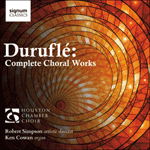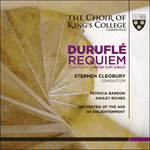
Welcome to Hyperion Records, a British classical label devoted to presenting high-quality recordings of music of all styles and from all periods from the twelfth century to the twenty-first.
Hyperion offers both CDs, and downloads in a number of formats. The site is also available in several languages.
Please use the dropdown buttons to set your preferred options, or use the checkbox to accept the defaults.

The choral ensemble is streamlined to very simple dimensions: a unison ensemble of baritone voices, with a baritone soloist featured in various sections of the work. In that solo/choral arrangement, it simulates the monastic practice of alternately singing phrases or verses of Gregorian chant antiphonally in two groups, or responsorially by a cantor alternating with a larger chorus.
Like Duruflé’s better-known Requiem, the instrumental accompaniment was originally composed for orchestra and organ, with subsequent arrangements calling for a smaller instrumental ensemble and organ, or organ alone as it is heard in this performance. The general simplicity of the musical texture and the economy of forces make the Mass 'Cum Jubilo' an ideal piece of liturgical service music, available for wide use by choirs of varying sizes and abilities.
The three-part 'Kyrie eleison' is sung quietly by the full chorus, with a running figure in the organ part that periodically imitates the beginnings or endings of vocal phrases during interludes between them. The 'Gloria' is a much bolder piece, beginning with a forceful introduction by the organ and full-throated singing by the male chorus throughout the divine praises. After a quiet moment during the 'Gratias agimus tibi', the first section rises to a climactic ending, then quickly gives way to a quiet set of running notes that introduce the central petitions sung by the soloist. These pleas for mercy are underscored by subtle melodic imitations between the vocal line and the organ. An animated tempo accompanies the closing section, climaxed by a much-repeated choral 'Amen'.
The final three movements gently lead the listener deeper and deeper into complex tonal implications. Given the bright Lydian-mode scale patterns of the 'Sanctus' and 'Agnus Dei' plainchants, it is surprising to find Duruflé moving its melodic phrases to higher or lower tonal areas, while harmonizing them with unrelated chordal sequences in the organ part. The jubilant text of the 'Sanctus' movement is also delivered at a subdued volume level, rising to its loudest choral singing only in the climactic 'Hosanna's toward the end.
The 'Benedictus' is sung by the soloist, and the complex harmonies of the thrice-repeated 'Agnus Dei' are gently intoned by the chorus in the midst of ever-softer, ever-more-relaxed organ interludes, ultimately resolving themselves in the final chord.
from notes by Carl R Cunningham © 2016
extrait des notes rédigées par Wadham Sutton © 1989
Français: Hypérion
aus dem Begleittext von Wadham Sutton © 1989
Deutsch: Anke Vogelhuber
 Duruflé: Complete Choral Works Duruflé: Complete Choral WorksA debut Signum recording from the Houston Chamber Choir presents the complete choral output of Maurice Duruflé, compositions as carefully crafted as they are infused with the Gregorian traditions of the distant French past to which their composer ...» More |
 Duruflé: Requiem & other choral works Duruflé: Requiem & other choral worksKing’s College Choir joins with the Orchestra of the Age of Enlightenment and soloist Patricia Bardon in a wonderful new recording of Duruflé's Requiem.» More |

